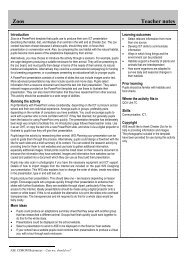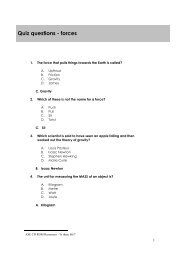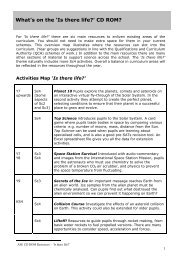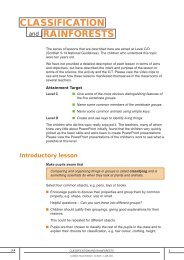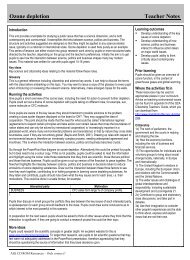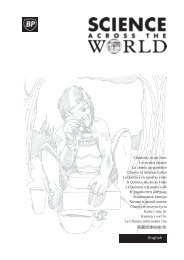Role-play in science teaching and learning - ASE Science Year CD ...
Role-play in science teaching and learning - ASE Science Year CD ...
Role-play in science teaching and learning - ASE Science Year CD ...
Create successful ePaper yourself
Turn your PDF publications into a flip-book with our unique Google optimized e-Paper software.
<strong>Role</strong>-<strong>play</strong> <strong>in</strong> <strong>science</strong> teach<strong>in</strong>g <strong>and</strong> learn<strong>in</strong>g<br />
McSharry <strong>and</strong> Jones<br />
Table 4 Some examples of the uses of analogy role-<strong>play</strong> <strong>and</strong> simulation <strong>in</strong> the <strong>science</strong> curriculum.<br />
Type of role-<strong>play</strong><br />
Area of curriculum that can be described<br />
Biology Chemistry Physics<br />
Analogy<br />
Circulatory system<br />
Structure <strong>and</strong> function of<br />
cells (Figure 2)<br />
Enzyme action<br />
Phagocytosis<br />
Transpiration<br />
Antibody/antigen<br />
<strong>in</strong>teraction<br />
Predation<br />
Atomic structure (Figure 3)<br />
Valency<br />
Concentration effects<br />
Surface area effects<br />
Gas laws<br />
Diffusion<br />
Sea-floor spread<strong>in</strong>g<br />
K<strong>in</strong>etic theory<br />
States of matter<br />
Expansion (Figure 4)<br />
Electricity/electrical circuits<br />
Absorption of colour (see<br />
Batts, 1999)<br />
Refraction <strong>and</strong> reflection<br />
Movement of the planets<br />
<strong>and</strong> moons<br />
Simulation<br />
Environmental issues<br />
(SATIS no. 1206)<br />
Drug use<br />
Sex education debates<br />
Ethics of genetic<br />
manipulation<br />
Environmental issues<br />
Ethics of oil extraction<br />
Ethics of raw material<br />
extraction<br />
Industrial hazards (SATIS<br />
no. 1002)<br />
Use of fuels/renewable<br />
energy<br />
Use of nuclear fuel (SATIS<br />
no. 109)<br />
Noise pollution<br />
start (wall or l<strong>in</strong>e)<br />
direction of ‘impulse’<br />
f<strong>in</strong>ish<br />
Explanation<br />
1 Choose a fast runner from the class. L<strong>in</strong>e<br />
the rest of the class up, with arms<br />
outstretched so that they are just able to<br />
touch h<strong>and</strong>s.<br />
2 The idea is for the ‘nerve cell’ to pass-on an<br />
impulse from one to the next by touch<strong>in</strong>g<br />
the next person’s h<strong>and</strong>, while the runner<br />
tries to beat them to the f<strong>in</strong>ish.<br />
3 After a few practices, say ‘Go!’<br />
This role-<strong>play</strong> shows that nerve cells can pass<br />
on messages quicker than an isolated,<br />
moveable cell because they are long – <strong>and</strong><br />
have a fixed position. Comparisons can also<br />
be made between nerve <strong>and</strong> hormone action.<br />
lone runner attempts to beat ‘impulse’ to f<strong>in</strong>ish l<strong>in</strong>e<br />
Figure 2 A role-<strong>play</strong> to describe the structure <strong>and</strong> function of a nerve cell.<br />
Us<strong>in</strong>g role-<strong>play</strong><br />
Many teachers may fear teach<strong>in</strong>g <strong>in</strong> an ‘active’ way<br />
because of a perceived loss of control. Control <strong>in</strong><br />
‘creative’ situations is derived from the structure that<br />
the teacher applies to classroom management, <strong>in</strong> much<br />
the same way as <strong>in</strong> traditional lessons; for example,<br />
the application of good plann<strong>in</strong>g, fair <strong>and</strong> clear class<br />
rules, str<strong>in</strong>gent tim<strong>in</strong>g, clear <strong>in</strong>structions <strong>and</strong> a calm,<br />
positive delivery. Anyth<strong>in</strong>g that happens with<strong>in</strong> that<br />
structure rema<strong>in</strong>s under the teacher’s control, <strong>and</strong> is<br />
not normally due to any chaotic willfulness on the part<br />
of the taught.<br />
However, role-<strong>play</strong> is, of course, open to the<br />
potential of unruly behaviour, because <strong>in</strong> some cases<br />
it is actually quite difficult to teach (simulations <strong>in</strong><br />
particular), dem<strong>and</strong><strong>in</strong>g a great deal of judgement, skill<br />
<strong>and</strong> sensitivity to group dynamics. And sometimes the<br />
78 School <strong>Science</strong> Review, September 2000, 82(298)





